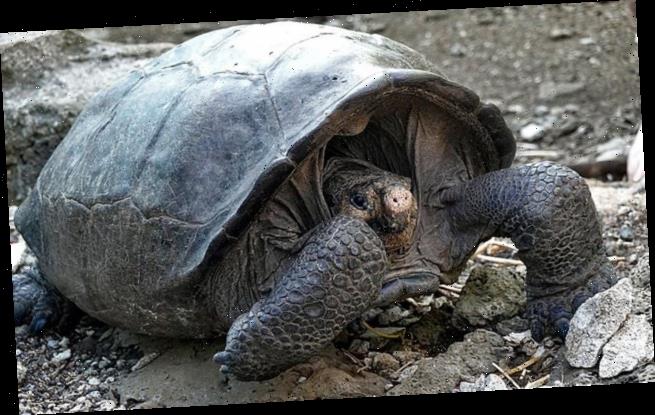Scientists find living relative of a tortoise subspecies thought to have gone extinct in 2012 on island in the Galápagos
- A newly discovered tortoise bodes well for a supposedly extinct subspecies
- Experts say it’s a relative to a subspecies thought to have gone extinct in 2012
- A direct decedent of the subspecies may exist elsewhere on the island
- Last year, researchers made a similarly significant discovery
- They found a species thought to have gone extinct 100 years ago
A supposedly extinct species of tortoise may in fact live on .
According to researchers in the Galapagos Islands, a recently discovered tortoise bears a strong genetic link to an ancestor dubbed, ‘Lonsome George’ – the last known member of the Chelonoidis nigra abingdonii Pinta subspecies which died in 2012.
Researchers at Galapagos National Parks say the expedition – which launched last month at Wolf Volcano on Isabela Island – discovered a young, female specimen deemed ‘a high-importance find because it has a strong genetic component of the species, Chelonoidis abingdonii.’
Researchers made a surprising discovery with a tortoise that genetically resembles a species thought to have gone extinct in 2012. Pictured above is A specimen of the giant Galapagos tortoise Chelonoidis phantasticus, thought until recently to have gone extinct a century ago
They say the genetic link suggests that there could be a pure surviving member of the species hiding out on the island.
‘[She] could be a direct descendant of a pure individual, which could still be alive somewhere,’ the park said.
The species, like many species of giant tortoise, were over-hunted for their meat by European and other colonists who traveled to the Galapagos archipelago.
Park rangers and scientists from the Galapagos Conservancy say they found an additional 29 tortoises, including 11 males and 18 females, that share part of their genetic makeup with the Chelonoidis niger Floreana subspecies, which are also thought to be extinct.
Lonesome George (pictured in 2009) was roughly 100 years old when he died back in 2012 0 a loss that was thought to mark the official extinction of his species
The discovery of a potential relative to Lonesome George, is the latest sign of hope since a discovery made last year.
In 2019, a species of female giant tortoise believed to have gone extinct more than 100 years ago was spotted in the Galapagos Islands.
The sighting came during an expedition to the island of Fernandina in the western Ecuadorian region of the archipelago funded by Animal Planet for an upcoming documentary series titled ‘Extinct or Alive’.
‘Much like Lonesome George was an icon of extinction, I believe she can become an icon of wildlife hope. She’s the rarest tortoise, if not animal, in the entire world and one of the largest discoveries in the Galapagos in the last century,’ said expedition leader Forrest Galante at the time.
Scientists believe that tortoises first arrived in the Galapagos two to three million years ago after drifting 600 miles from the South American coast on vegetation rafts.
They were already large reptiles before arriving on the Islands.
Charles Darwin visited the Galapagos for five weeks on his second voyage and they appeared in his writings, playing a key role in the development of the theory of evolution.
He observed different finches on different islands but theorized they had evolved from the same species.
Differences in beak size and shape married up with the available food sources on the respective islands, birthing the theory of natural selection.
WHAT ARE THE GALAPAGOS ISLANDS?
The Galapagos islands are situated 563 miles west of mainland Ecuador, of which they are a part. They are some of the most remote land masses in the world.
There are 21 islands but only four of them are inhabited, with a population of around 25,000.
They contain more than 1,300 species found nowhere else on earth. With the islands at the intersection of three ocean currents, the sea is a mecca for marine life.
The most famous species unique to the Galapagos include the giant tortoise, marine iguana, flightless cormorant and the Galapagos penguin – the only penguin species to be found in the Northern Hemisphere.
Unesco decided to declare Galapagos a World Heritage Site In Danger in 2007 due to a boom in tourism.
Indeed, annual visitor numbers have increased from 12,000 in 1979 to more than 300,000 today.
Dozens of Galapagos species are now ‘critically endangered’.
Source: Read Full Article


